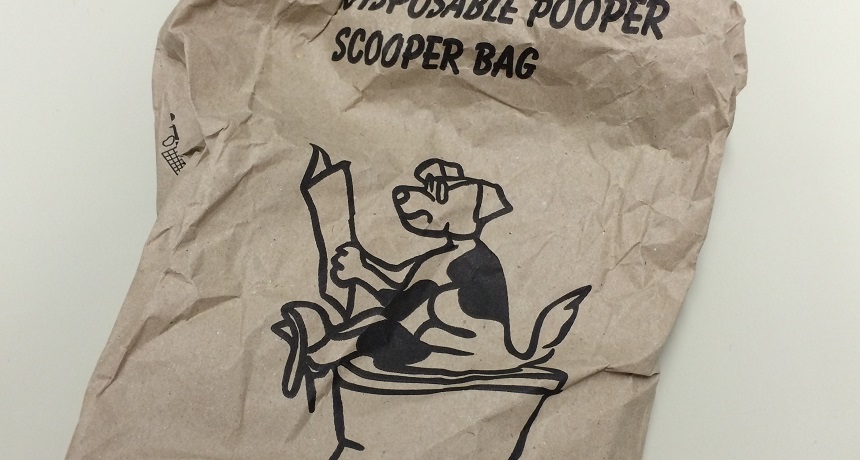IgNobel prize honors scoop on the way dogs poop

A study on the direction dogs face when they poop won the 2014 IgNobel prize in biology. The researchers handed out these “doggie bags” to advertise their new app.
B. Brookshire/SSP
Dogs like to take their time when choosing a bathroom spot. It may take several trials, a lot of sniffing and a few circling turns for Rover to get comfortable before he settles down to dump. Maybe you look away at this point, to give your pup a little privacy.
But maybe you shouldn’t. Instead, perhaps, you should take the opportunity to get some data. A 2013 study has shown that dogs have a preference for their pooping and peeing positions. They tend to align themselves from north to south. This means that dogs might be able to sense the direction of Earth’s magnetic field, the authors conclude.
The study won the 2014 IgNobel prize in biology. The IgNobel prizes honor scientific studies that might sound silly at first. But after you finish laughing, there is often an important lesson to be learned.
The inside of our planet contains a swirling mix of melted magnetic metals. As the electrically charged metals move around, they produce a magnetic field that extends from pole to pole. We detect this magnetic field with a compass. The compass has a magnet which aligns itself with Earth’s magnetic field, letting us know which way is north.
Hynek Burda is a sensory biologist at the Czech University of Life Sciences in Praha. He has been observing for many years that animals have a tendency to align their bodies north to south when they are relaxing. This means their heads might point either south or north, as opposed to east or west. His laboratory has seen this in animals such as as cows and deer.
While Burda has studied many species, his lab was especially interested in dogs. “They are so convenient,” he says. “They are everywhere around the world. Dogs can orientate and navigate really well. Their ancestors moved over very long distances. They can navigate even in dense vegetation or in the dark.”
To see whether dogs also respond to Earth’s magnetic field, Burda’s lab recruited friends, coworkers and neighbors to walk their dogs and record what they witnessed. The scientists were careful to make these sightings away from powerlines or other electrical devices which might disrupt the ability of these pets to sense Earth’s magnetism. In all, 70 dogs of all different breeds roamed free as part of these tests.
Anyone who has walked a dog will notice that they always seem busy. The dogs sniffed and chewed and ran around with seemingly little evidence of intentional direction. But when the scientists analyzed the data, they found that dogs tend to point either north-to-south or south-to-north when they are squatting to poop. They observed some similar effects during urination.
But dogs don’t head north-to south-all the time. Earth’s magnetic field in any particular location varies slightly during the 24-hour rotation of the planet. But the chance they chose a north-south alignment was highest when Earth’s magnetic field was particularly calm. That tends to be only about 20 percent of the time, and usually at night. They published the study Dec. 27, 2013, in Frontiers in Zoology.
In truth, Burda notes, the effects are hard to see. Earth’s magnetic field is often disturbed by rough weather, power lines and other natural and human activities. Dogs too can be easily distracted by other things in the environment such as wind, sunlight or squirrels.
Burda and his group want to collect more data about how dogs might align themselves. So they have made a free app for your smartphone. For now, it is available for iPhone only. But any iPhone users can now dog their pets’ behavior to collect bonus data for Burda’s study.
All you have to do is take a dog for a walk. When the dog squats to do its business, align your phone parallel to your dog and press the screen to submit the direction. You can then fill out information on whether the dog was on a leash, whether it was pooping or peeing and what type of dog it was.
Burda hopes that winning the IgNobel prize will let more people know about the research, and that his app will recruit more citizen scientists to expand the wealth of data he has to analyze. “Everyone at home can replicate this,” he says.
Follow Eureka! Lab on Twitter
Power Words
app Short for application, or a computer program designed for a specific task.
citizen science Scientific research in which the public — people of all ages and abilities — participate. The data that these citizen “scientists” collect helps to advance research. Letting the public participate means that scientists can get data from many more people and places than would be available if they were working alone.
electric field A region around a charged particle or object within which a force would be exerted on other charged particles or objects.
electric current A flow of charge, called electricity, usually from the movement of negatively charged particles, called electrons.
geomagnetic field The magnetic field surrounding Earth.
magnet A material that usually contains iron and whose atoms are arranged so they attract certain metals
magnetic field An area of influence created by certain materials, called magnets, or by the movement of electric charges.
magnetosphere The region surrounding Earth (or another astronomical body) in which its magnetic field protects the planet from the solar wind.